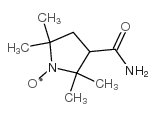3-Carbamoyl-2,2,5,5-tetramethyl-3-pyrrolidine-1-yloxy

3-Carbamoyl-2,2,5,5-tetramethyl-3-pyrrolidine-1-yloxy structure
|
Common Name | 3-Carbamoyl-2,2,5,5-tetramethyl-3-pyrrolidine-1-yloxy | ||
|---|---|---|---|---|
| CAS Number | 4399-80-8 | Molecular Weight | 185.24300 | |
| Density | 1.082g/cm3 | Boiling Point | 341.8ºC at 760 mmHg | |
| Molecular Formula | C9H17N2O2 | Melting Point | 173-175ºC(lit.) | |
| MSDS | Chinese USA | Flash Point | 160.5ºC | |
|
Hepatic reduction of carbamoyl-PROXYL in ferric nitrilotriacetate induced iron overloaded mice: an in vivo ESR study.
Biol. Pharm. Bull. 35(7) , 1035-40, (2012) Reduction of a nitroxyl radical, carbamoyl-PROXYL in association of free radical production and hepatic glutathione (GSH) was investigated in iron overloaded mice using an in vivo L-band electron spin resonance (ESR) spectrometer. Significant increases in hep... |
|
|
Monitoring redox-sensitive paramagnetic contrast agent by EPRI, OMRI and MRI.
J. Magn. Reson. 190(1) , 105-12, (2008) A comparative study of tissue redox-status imaging using commonly used redox sensitive nitroxides has been carried out using electron paramagnetic resonance imaging (EPRI), Overhauser magnetic resonance imaging (OMRI) and conventional T(1)-weighted magnetic r... |
|
|
Non-invasive analysis of reactive oxygen species generated in rats with water immersion restraint-induced gastric lesions using in vivo electron spin resonance spectroscopy.
Free Radic. Res. 38(2) , 147-55, (2004) Reactive oxygen species (ROS) are reportedly associated with gastric ulcer. We previously reported the use of an in vivo 300-MHz electron spin resonance (ESR) spectroscopy/nitroxyl probe technique to detect *OH generation in the stomachs of rats with gastric ... |
|
|
In vivo detection of gastric cancer in rats by electron paramagnetic resonance imaging.
Cancer Res. 64(18) , 6495-502, (2004) Electron paramagnetic resonance imaging (EPRI) enables noninvasive spatial mapping of free radical metabolism and has recently been shown to provide in vivo physiologic information regarding alterations in the redox state of tumors and neoplastic tissues. Wit... |
|
|
Comparison of stable nitroxide, 3-substituted 2,2,5,5-tetramethylpyrrolidine-N-oxyls, with respect to protection from radiation, prevention of DNA damage, and distribution in mice.
Free Radic. Biol. Med. 40(7) , 1170-8, (2006) We compared three 3-substituted 2,2,5,5-tetramethylpyrrolidine-N-oxyls (PROXYLs): carbamoyl-, methoxycarbonyl-, and hydroxymethyl-PROXYL (CM-, MC-, and HM-PROXYL, respectively) with respect to radioprotection, prevention of DNA damage, and in vivo distributio... |
|
|
Tissue Prx I in the protection against Fe-NTA and the reduction of nitroxyl radicals.
Biochem. Biophys. Res. Commun. 339(1) , 226-31, (2006) Peroxiredoxin I (Prx I) is a key cytoplasmic peroxidase that reduces intracellular hydroperoxides in concert with thioredoxin. To study the role of tissue Prx I in protection from oxidative stress, we generated Prx I-/- mice by gene trapping. We then evaluate... |
|
|
Organ specific mapping of in vivo redox state in control and cigarette smoke-exposed mice using EPR/NMR co-imaging.
J. Magn. Reson. 216 , 21-7, (2012) In vivo mapping of alterations in redox status is important for understanding organ specific pathology and disease. While electron paramagnetic resonance imaging (EPRI) enables spatial mapping of free radicals, it does not provide anatomic visualization of th... |
|
|
Nitroxide derivatives for imaging of hypercholesterolemia-induced kidney dysfunction and assessing the effectiveness of antilipidemic drugs.
Mol. Pharm. 8(5) , 1962-9, (2011) The present study was designed to clarify the possibility for application of nitroxide derivatives in magnetic resonance imaging (MRI) of hypercholesterolemia-mediated renal dysfunction in mice, as well as to assess the effectiveness of antilipidemic drugs (c... |
|
|
Cell-penetrating nitroxides as molecular sensors for imaging of cancer in vivo, based on tissue redox activity.
Mol. Biosyst. 8(10) , 2733-40, (2012) The present study shows that hydrophobic and cell-penetrating piperidine-type nitroxide radicals SLENU and TEMPOL, but not hydrophilic and partially penetrating or non-penetrating pyrrolidine-type nitroxides carbamoyl-PROXYL and carboxy-PROXYL, are appropriat... |
|
|
Tempol in the dorsomedial hypothalamus attenuates the hypertensive response to stress in rabbits.
Am. J. Hypertens. 19(4) , 396-402, (2006) We have recently shown that microinjection of the superoxide dismutase mimetic tempol into the pressor region of the rostral ventrolateral medulla attenuates the cardiovascular response to mental (air-jet) stress in rabbits. In the present study, we examined ... |